(Find out which ones are breaking the rules!)
I recently came across an article on the Ahrefs blog – 7 Successful Amazon Affiliate Websites (That You Can Learn From). People must really like the article because I’ve seen it shared more than once in a few affiliate marketing Facebook groups that I am in. The author of that post did a really good job at finding several of the top Amazon affiliate websites and pointing out some of the unique things they are doing that are contributing to their success.
Now it’s my turn to point out a few things that I noticed as I looked at each of the Amazon affiliate website examples they covered. Even though these sites are touted as ‘successful’ – I see obvious room for improvement in each of them. One thing that really stood out to me is the obvious disregard that many of them show towards obeying Amazon’s policies.
Let’s not beat around the bush. Let’s get straight to the point here. Some of the bigger Amazon affiliate websites seem to be privileged by a different set of rules than the rest of us have to abide by. I’m talking about the Amazon Associates Operating Agreement and Associates Program Policies. Sure, the policies are sometimes vague, difficult to understand, and seemingly open to interpretation. But some of the rules are clear as day and many Amazon affiliate websites I come across seem to blatantly disregard Amazon’s policies. It’s really unbelievable what some of these larger sites get away with!
Also good to note, many popular Amazon affiliate WordPress plugins break compliance rules, and we always make sure AmaLinks Pro® will keep your account safe.
Let’s dig in and see what we can find…
1. The Prepared
A popular blog in the prepper/survival niche – Here are a few quotes from the Ahrefs blog article about this site…
Why they’re doing so well
The success of this particular site falls largely down to its owners’ focus on creating content about evergreen topics.
Evergreen topics are those with consistent interest and search volume over time. For example, we can see that The Prepared targets keywords like “best blue tarp.”
How to replicate their success
Focus on creating “best [x]” posts for evergreen product categories. These are things that people will still be looking to buy in years to come.
Here are my observations
I visited the site and immediately clicked on Reviews & Guides in their header menu and went to the Gear section to find a product review article. Here is their review for ‘Best portable solar chargers’. I have to admit – the content is insanely long and detailed and they obviously go way above & beyond to thoroughly test products.
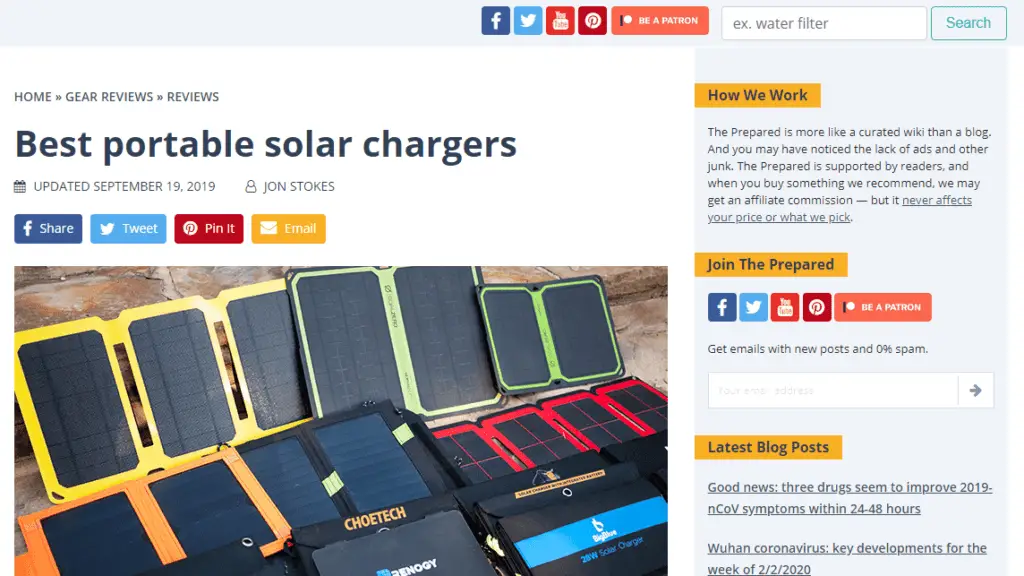
Here is how they violate Amazon’s policies
They do not clearly identify themselves as an Amazon affiliate. Period. In fact, I didn’t see anywhere on that page where they identified themselves as an Amazon affiliate at all. The closest thing I could find was the blurb at the top of their sidebar under the ‘How We Work’ section where it reads…
The Prepared is more like a curated wiki than a blog. And you may have noticed the lack of ads and other junk. The Prepared is supported by readers, and when you buy something we recommend, we may get an affiliate commission — but it never affects your price or what we pick.
Amazon’s policy regarding this is extremely clear. Here is how it reads…
You must clearly state the following, or any substantially similar statement previously allowed under this Agreement, on your Site or any other location where Amazon may authorize your display or other use of Program Content: “As an Amazon Associate I earn from qualifying purchases.”
They cloak their links. Hover over any Amazon affiliate link in one of their posts and you will see that it looks something like this…
https://theprepared.com/pick/g-port-solar-ryno-tuff-solar-charger-dual-usb-solar-panel-21w-amzn/
This is a cloaked link. The URL appears to be another URL on their website – but it redirects to the Amazon product page using their Tracking ID. Amazon’s policy on this can’t be any more clear. Here is how it reads…
You will not cloak, hide, spoof, or otherwise obscure the URL of your Site containing Special Links (including by use of Redirecting Links) or the user agent of the application in which Program Content is displayed or used such that we cannot reasonably determine the site or application from which a customer clicks through such Special Link to an Amazon Site.
It’s possible that these particular ‘cloaked’ links are allowable under the clause in that statement – “that we cannot reasonably determine the site or application from which a customer clicks through such Special Link to an Amazon Site.” Because the end of the link includes amzn – perhaps this is reasonable enough for somebody to determine that the link is leading to Amazon.
But in my opinion – it would be better to stay safe and not cloak links at all.
They upload Amazon images to their WordPress database. It’s not difficult to right-click on product images on their pages and inspect the source code and see that the images are being served from the /wp-content/uploads/ folder on their website.
This is another extremely clear violation of Amazon’s policies. Here is how they read regarding images…
You will not store or cache Product Advertising Content consisting of an image, but you may store a link to Product Advertising Content consisting of an image for up to 24 hours.
It’s hard to say for sure that they ‘stole’ their images from Amazon. Perhaps they got them somewhere else with permission. But, they are using the exact same images that are featured on Amazon – so, it’s pretty safe to assume that they downloaded the images from Amazon and then uploaded them to their website.
They display inaccurate pricing information. I almost missed this violation because it is displayed in an awful-looking table way down in the middle of the extremely long article. The table they display is obviously some sort of spreadsheet import – and within it they include static prices. Here is what the table looks like on their site…
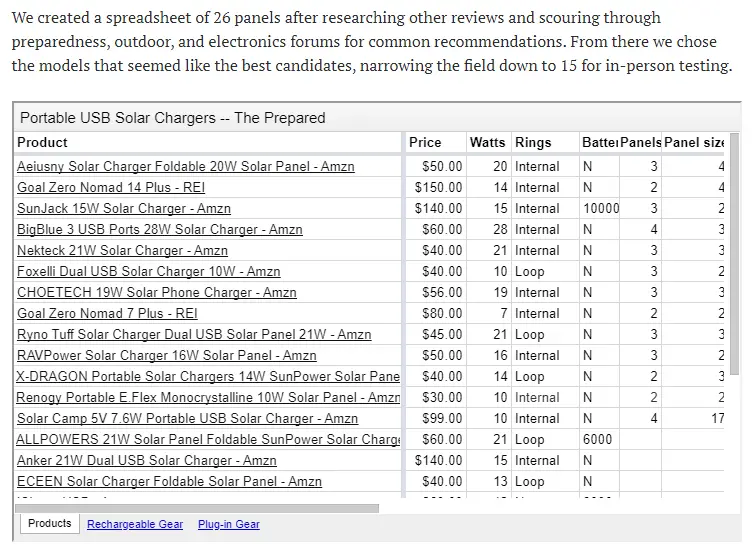
This is yet another blatant violation of Amazon’s policies. Amazon’s policy regarding this is extremely clear. Here is how it reads…
You must not make inaccurate, overbroad, deceptive or otherwise misleading claims about any Product, an Amazon Site, or any of our policies, promotions, or prices.
I underlined the words inaccurate and prices – as the prices shown in their table are clearly inaccurate. I only clicked on a couple of the links in the table to verify that they don’t match the actual prices on Amazon.
They link to other online stores on the same pages that they use Amazon data (images) to promote products. This is a lesser-known and somewhat obscure violation – but nevertheless it IS a violation.
Amazon does not want you to (and they do not allow you to) use information from their site or their PA-API to promote or sell products on other websites. Can you blame them? Here is how the rule reads within Amazon’s policies…
You will not display on your Site, or otherwise use, any Program Content to advertise or promote any products that are offered on any site that is not an Amazon Site (e.g., products offered by other retailers).
The words, “any Program Content,” refer to anything made available by Amazon (like images). Just on this one review article alone – I found that they use Amazon images to promote products and they also link to products on NewEgg. Amazon’s rules clearly state that you cannot link to other online stores if you use Amazon content to promote products.
Here is how they could improve
The Prepared is obviously an outstanding affiliate website. But – they have a LOT of room for improvement. Unless they somehow got a special pass from Amazon and got permission to violate all of these policies – they have a ton of work to do to clean up their site and make it compliant with Amazon’s policies for Amazon Associates.
Although the content is thorough and laid out nicely – I also think it could be slightly improved by adding some really nice product comparison tables – especially towards the top of their ‘best [product]’ type articles.
2. Homegrounds
A popular blog in the coffee or ‘home barista’ niche – Here are a few quotes from the Ahrefs blog article about this site…
Why they’re doing so well
- Firstly, we commit to publishing content that is better than our competitors.
- Secondly, we reverse engineer our competitors
- Finally, we dig deeper into keywords and think about search intent, rather than just looking at search volume.
How to replicate their success
- Do keyword research and find topics with traffic potential.
- Create content that aligns with search intent and trumps everything else on quality.
- Build links to the content by replicating competitors’ link building strategies.
Here are my observations
I visited the site and immediately clicked on Gear in their header menu and went to the Espresso Machines section to find a product review article. Here is one of their review articles for ‘Best Espresso Machines’. This article features a mini-review for each of a WHOLE bunch of different espresso machines followed by some general informational content at the end.

Here is how they violate Amazon’s policies
They mention generalized pricing. Without a keen eye – this violation is almost hard to spot. They do not mention pricing within each mini-review. But… they do have several of their subheadings labeled with general pricing. For example: … Best Machines Under $100
Amazon’s policy regarding this is extremely clear. Here is how it reads…
You must not make inaccurate, overbroad, deceptive or otherwise misleading claims about any Product, an Amazon Site, or any of our policies, promotions, or prices.
I underlined the 2 of the important words in that statement; overbroad and prices. Amazon doesn’t allow ANY mention of price whatsoever. The reasoning is simple and clear. Prices on Amazon change constantly and published content on the web may not. Amazon does not want publishers to deceive their potential buyers by displaying pricing information that may not be accurate.
Here is how Amazon’s policy gets more specific as it continues like this…
Product prices and availability may vary from time to time. Because prices for and availability of Products that you have listed on your Site may change, your Site may only show prices and availability if: (a) we serve the link in which that price and availability data are displayed, or (b) you obtain Product pricing and availability data via PA API and you comply with the requirements regarding use of PA API in the License.
I actually clicked on all of the espresso machines mentioned on that page to see if they fit in the published criteria. They did on the date that I am writing this post – but a couple of them were dangerously close. For example: one of the espresso machines listed in the “Under $500” section was priced at $499.95.
It’s highly possible that many Ama affiliates are unaware that Amazon sellers have the ability to change their prices whenever they want without approval from Amazon or anybody else. If the seller for that espresso machine increased their price by even a nickel, then the review post that we are talking about would be deceptive.
Here is how they could improve
This particular article that I analyzed on HomeGrounds is not a bad article overall. They have okay-looking product info boxes for each of the espresso machines featured on the page. In my opinion – they should use a plugin (like AmaLinks Pro®) that connects to the API and just display the actual price in each product box! They’re placing the products under broad pricing categories anyway… so why not display the actual price?
If the fine folks over at HomeGrounds were to take my advice – I would advise them to remove the overbroad pricing from their subheadings and use Showcase Boxes from AmaLinks Pro® in place of their current product infoboxes.
It also wouldn’t hurt to add a nice product comparison table towards the top of the page.
[social_warfare]
3. Dog Food Advisor
A popular website in the dog food niche – Here are a few quotes from the Ahrefs blog article about this site…
Why they’re doing so well
It’s estimated that $75 billion was spent by pet owners in 2019, with $31 billion on pet food alone.
And therein lies the key to this site’s success. Instead of writing broadly on pets or even pet food, they chose to focus solely on dog food.
How to replicate their success
1. Create content hubs
Given that there are so many types of dog foods available for different breeds and for various purposes, it would be impossible to answer the question of “what is the best dog food” in a single article.
Instead, what this page does is internally link to more specialized articles on the subject, allowing readers to choose the one that applies most to them.
This is known as a “content hub.”
2. Create useful content that attracts links
Don’t focus solely on “best [x]” keywords. Create useful, informational content that attracts links and boosts your authority.
Here are my observations
Dog Food Advisor has an extraordinary amount of published content based on one very specific niche – dog food. It certainly appears like they have a full review published for each and every kind of dog food that exists on the planet – and there are a LOT of different brands and different types.
Each review is thorough and well-written. All of the reviews seem to follow the same format and provide readers with the information they need to make a buying decision. As far as I can tell – they monetize with affiliate links that point to Chewy.com or Amazon. After clicking through to several of their dog food review posts – it appears that most of their affiliate links point to Chewy.com.
It took me several attempts before I found a product that linked to Amazon as an affiliate. My guess is that Chewy.com is more lucrative and they link to Amazon if the product isn’t available on Chewy.com. That’s just a guess though. I have no idea! Here is a link to the Acana Dog Food Review on Dog Food Advisor, which links to Amazon as an affiliate.
One thing that stood out to me was the fact that this particular dog food review post has a ton of genuine comments published below the content. I think it’s safe to assume that all of their content gets a lot of comments like this. Seems crazy to me that people are so passionate about dog food that they take the time to comment on review posts about it. This is also an indicator of the amount of traffic that this site gets. Typically, only a small percentage of readers actually leave comments. You do the math… this site must get a TON of traffic!
Overall – Dog Food Advisor seems to be almost 100% legit and compliant. However, I did find one small snafu on only their pages that promote Amazon products.

Here is how they violate Amazon’s policies
They upload Amazon images to their WordPress database. It’s not difficult to right-click on product images on their pages and inspect the source code and see that the images are being served from the /wp-content/uploads/ folder on their website.
This is another extremely clear violation of Amazon’s policies. Here is how they read regarding images…
You will not store or cache Product Advertising Content consisting of an image, but you may store a link to Product Advertising Content consisting of an image for up to 24 hours.
It’s hard to say for sure that they ‘stole’ their images from Amazon. Perhaps they got them somewhere else with permission. But, they are using the exact same images that are featured on Amazon – so, it’s pretty safe to assume that they downloaded the images from Amazon and then uploaded them to their website.
Here is how they could improve
Overall, there is very little that I think Dog Food Advisor needs to do to improve. Obviously, they need to fix their issue of using uploaded Amazon images on their pages that promote Amazon products. That could be easily achieved by adding SiteStripe images in place of what they have – or, even better, use an awesome plugin like AmaLinks Pro® to insert images.
I also think that they could increase conversions even more if they added a comparison table to each and every review post. For example: on any of their posts, including the ones that link to dog food on Chewy.com, they could add a nice section with a heading – Compare to These Top Products on Amazon – then easily toss in a nice comparison table using AmaLinks Pro®.
[social_warfare]
4. PCPartPicker
A popular website in the PC (personal computer) niche – Here are a few quotes from the Ahrefs blog article about this site…
Why they’re doing so well
PCPartPicker is interesting because it deviates from the traditional affiliate model of targeting “best [x]” keywords.
Instead, it’s a tool.
Knowing which components to buy is a big problem in the “build your own PC” world. PCPartPicker solves this by letting you shop for the latest PC parts based on performance and budget. It then automatically cross-references them to check for compatibility.
Then, based on what you’ve configured, you can purchase directly from Amazon (with PCPartPicker’s affiliate links.)
How to replicate their success
Not all Amazon affiliate websites must be “content sites” to do well. There are other ways to excel.
Is there a big problem in your niche? Can you build a free tool or resource to help fix that problem and potentially make some affiliate income along the way?
Sometimes, you have to think outside the box.
Here are my observations
Wow! Who knew that such an incredibly valuable resource could also be such a highly successful affiliate website! When you really think about it… it’s easy to see how a site like this could and should be the MOST successful as an affiliate. They are not trying to push their readers/users into buying any products based on the affiliate commissions they could receive. In fact, they are not even really reviewing products – for the most part. Instead, they are just supplying an extremely valuable tool for people who wish to build their own PC’s.
This website is such a “think outside the box” type of example that it’s hard for me to really comment on or constructively criticize. I have to admit – my perspective of what “Amazon affiliate websites” are (or should be) has been stuck on the traditional Amazon review style websites. Seeing what PCPartPicker has created has given me a whole new frame of reference for how Amazon commissions could be earned.
In order to analyze and try to constructively criticize this site – I opened up the PCPartPicker ‘System Builder’ tool and started to play around with it.
It’s really a nifty tool if you’re into the whole ‘build your own PC’ kind of thing. You select a component type, and then a whole list of products opens up for you with various specs and information. You click the ‘Add’ button for the product that you want and it essentially adds it to your cart on PCPartPicker. When you are ready to buy – it then redirects you to various merchants (with their affiliate link) where you can complete your purchase.
Amazon is just one of several merchants that they link to. I did, of course, find some issues that make them non-compliant with Amazon’s policies.
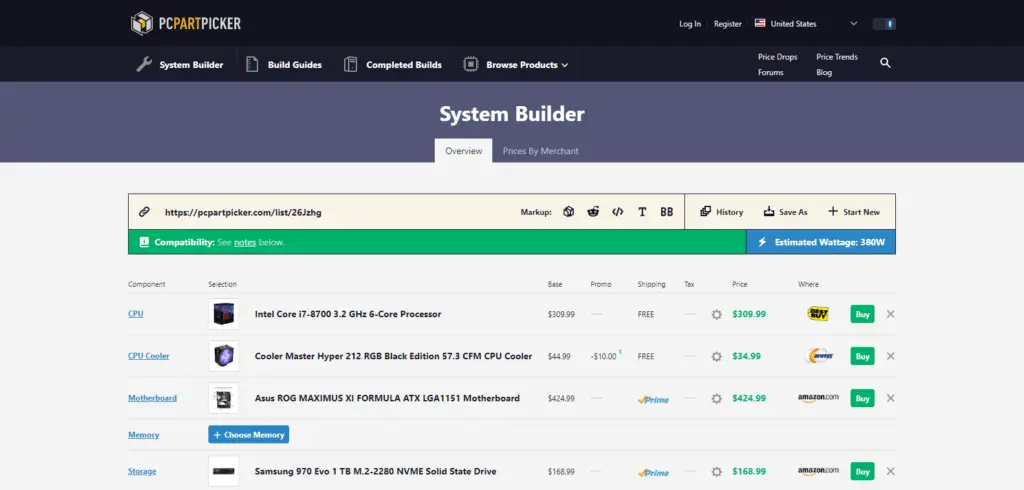
Here is how they violate Amazon’s policies
They do not include a date/time stamp near their pricing data for Amazon products. Amazon prices change constantly. It appears that PCPartPicker is pulling pricing data from Amazon’s API. I checked several products and the prices match the actual prices on Amazon exactly.
Amazon’s rules regarding the display of a date/time stamp are extremely clear. They even include examples of acceptable formats. Here it is, straight from the Operating Policies page…
You will include a date/time stamp adjacent to your display of pricing or availability information on your application if you obtain Product Advertising Content from Data Feeds, or if you call PA API or refresh the Product Advertising Content displayed on your application less frequently than hourly.
Examples of acceptable messaging include:
• Amazon.com Price: $ 32.77 (as of 01/07/2008 14:11 PST- Details)
• Amazon.com Price: $ 32.77 (as of 14:11 EST- More info)
I did not see date/time stamps anywhere on the PCPartPicker Site Builder tool. This could become problematic. For example: somebody could open up their tool and use it to start building a PC one day. Then maybe they leave and come back the next day and don’t refresh the window. The pricing from the day before is still displayed – but what if one of the Amazon prices changed? Now it appears that PCPartPicker is displaying incorrenct pricing info. If the date/time stamp were present – it would clearly identify the exact moment when the pricing info was pulled in from Amazon.
They use the Amazon logo and the Amazon Prime logo. Amazon only allows its affiliates the use of ‘Amazon marks’ that they make available for us and they DO NOT make the Amazon logo or the Amazon Prime logo available.
This rule by Amazon is a little bit obscure and seemingly misleading in their policy documents. Here is how the first line reads in the Amazon Operating Policies…
YOU ARE ALLOWED TO USE THE AMAZON MARKS ONLY BY DISPLAY ON YOUR SITE WITH THE PURPOSE OF ADVERTISING AVAILABILITY OF PRODUCTS ON AN AMAZON SITE, WITH A CORRESPONDING SPECIAL LINK TO THAT SITE.
Seems pretty clear. We ARE aloud to use Amazon marks then, right? Not so fast! If you keep reading under the Trademark Guidelines section – it goes on like this in point number 4…
We will supply an image or images of the Amazon Marks for you to use. You may not alter any Amazon Mark in any manner.
“We will supply an image or images of the Amazon Marks for you to use.” That’s where they get you! Amazon DOES NOT supply us with their logo or the Amazon Prime logo to use in any manner whatsoever. People who do display the Amazon logo or the Amazon Prime logo on their websites have obtained those images likely without permission. I had a nice little chat with an Amazon rep where I asked specific questions regarding all of this. Check out this post that contains absolute proof that it is not allowable to use the Amazon logo or the Amazon Prime logo on your website or blog.
Here is how they could improve
It wouldn’t be very difficult at all for PCPartPicker to fix these minor issues.
Adding a date/time stamp would be a cinch. Their site is obviously custom coded and they shouldn’t have an issue adding a date/time stamp anyplace that pricing is shown. Not only would this make them compliant with Amazon – but it would be helpful for the other vendor pricing that they display as well.
My other suggestion is far less likely to happen. Since it violates Amazon’s policies to use their logo (and their Prime logo) – PCPartPicker could simply replace those with text. But, they also show logos for the other vendors that they use – so they would also have to switch those to text in order to stay consistent. Who knows… maybe PCPartPicker actually did get some sort of exemption from Amazon on this policy. But I seriously doubt they even asked.
[social_warfare]
5. Equipboard
A popular website and blog in the music equipment niche – Here are a few quotes from the Ahrefs blog article about this site…
Why they’re doing so well
As an affiliate site, Equipboard targets “best” keywords in their niche. That’s to be expected.
But they also tackle the affiliate model from a unique angle.
A big part of their site is the breakdown of the gear and tools that famous musicians use.
That’s pretty smart. In the music world, people want to be more like their idols. They want to play the guitar like Slash, rap like Eminem, or sing like Ariana Grande. Not only that, they want to use the same gear as these people.
How to replicate their success
Equipboard’s key to success is their unique selling point (USP): the breakdown of tools and instruments that famous musicians use.
But here’s the cool part: you can apply this same concept to other niches.
Here are my observations
Equipboard uses another really unique, think-outside-the-box style, method of promoting affiliate products. I tried looking at an example. I clicked on Taylor Swift to see which equipment she uses and found that Equipboard seems to utilize quite a nifty (and probably complex) database. I clicked on one of the microphones that Taylor Swift uses and it brought me to a page about that mic, with buying options, and also showed me that 21 other artists use that same microphone and listed them out. Pretty neat!
But I was less interested in this facet of the website, which is also their unique selling proposition. I was more interested in their product review content. So, I clicked on the Gear Guides link in the header menu then ended up randomly clicking through to this post about the 7 Best Guitar Tuners on Equipboard. It’s pretty much a typical product review post. Very detailed with personal quotes from both of the co-founders of the site.
To the unsuspecting and average Amazon affiliate – this site seems totally legit. But like most of the others… I was able to spot a few compliance issues.
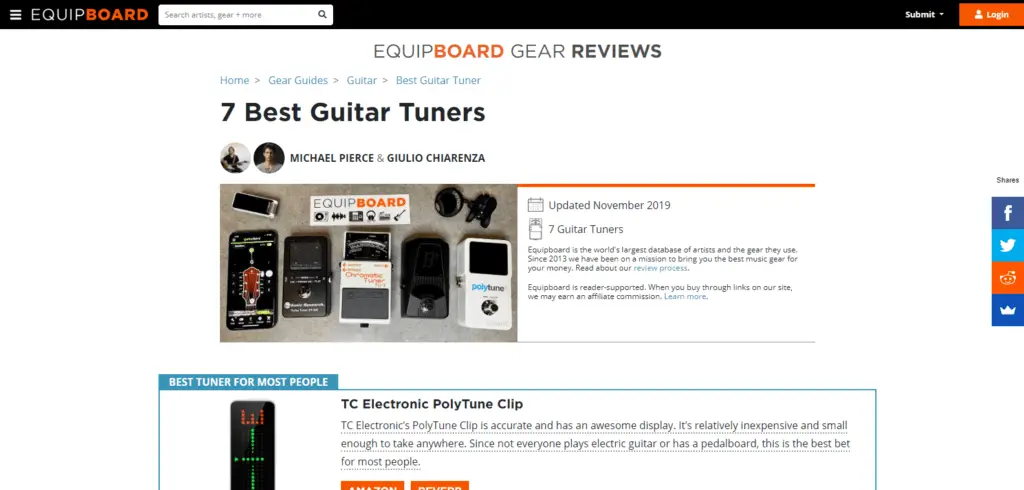
Here is how they violate Amazon’s policies
They upload Amazon images to their WordPress database. It’s not difficult to right-click on product images on their pages and inspect the source code and see that the images are being served from the /images.equipboard.com/uploads/… folder on their website.
This is another extremely clear violation of Amazon’s policies. Here is how they read regarding images…
You will not store or cache Product Advertising Content consisting of an image, but you may store a link to Product Advertising Content consisting of an image for up to 24 hours.
It’s hard to say for sure that they ‘stole’ their images from Amazon. Perhaps they got them somewhere else with permission. But, they are using the exact same images that are featured on Amazon – so, it’s pretty safe to assume that they downloaded the images from Amazon and then uploaded them to their website.
They link to other online stores on the same pages that they use Amazon data (images) to promote products. This is a lesser-known and somewhat obscure violation – but nevertheless it IS a violation.
Amazon does not want you to (and they do not allow you to) use information from their site or their PA-API to promote or sell products on other websites. Can you blame them? Here is how the rule reads within Amazon’s policies…
You will not display on your Site, or otherwise use, any Program Content to advertise or promote any products that are offered on any site that is not an Amazon Site (e.g., products offered by other retailers).
The words, “any Program Content,” refer to anything made available by Amazon (like images). Just on this one review article alone – I found that they use Amazon images to promote products and they also link to products on Reverb and Sonic Research. Amazon’s rules clearly state that you cannot link to other online stores if you use Amazon content to promote products.
Again, I could be wrong. Maybe they got the images from somewhere else with permission. But since they are the exact same images that are used and featured on Amazon, I doubt it.
Here is how they could improve
It certainly seems like Equipboard is caught in a pickle here. IF (and that’s a big if) they are obtaining their images from somewhere other than Amazon – then their site is 100% legit and nothing needs to be fixed. But… since many of the product images happen to be the exact same images as the featured image on Amazon – it’s safe to assume that they are uploading Amazon images to their site (which violates Amazon’s policies).
They could connect to the Amazon API and properly display their images that way (and they should) – but then they still have the issue of using Amazon content to promote products for sale on other platforms. To fix this issue – they would need to stop promoting products on other websites if they are promoting them on Amazon. OR… they could use images not from Amazon (like take their own pictures) and then they could promote exactly the way that they are.
Other than these few compliance issues – Equipboard is a phenomenal affiliate site!
[social_warfare]
6. Territory Supply
A popular blog in the hiking, backpacking, camping, and travel niche – Here are a few quotes from the Ahrefs blog article about this site…
Why they’re doing so well
The first thing you’ll notice when you visit Territory Supply is how much it looks like an online magazine, rather than a typical affiliate site.
And indeed, they do run their site like a magazine. As an affiliate site, they have articles targeting “best x” keywords. But they also cover plenty of other topics that don’t link to any products.
How to replicate their success
The takeaway: just because you run an affiliate site doesn’t mean you should only cover “best” or “review” topics. You should target topics at every stage of the marketing funnel.
Here are my observations
I really like this website and kind of wish that I owned one just like it! The site is a WordPress site – although it’s hard to tell because it’s built on a custom coded (and well-designed) theme. I explored the site a little bit and ended up getting lost in an article about cabins for rent in Michigan’s upper peninsula (one of my favorite places to visit).
Next – I clicked on the Gear link in the header menu. Right away – I noticed that several of their articles mention vague pricing right in the title. I knew right away that this would be an issue. I clicked over to this article about 6 Best Budget Hiking Boots Under $100. Sure enough, it didn’t take long to confirm my suspicions. I found more than one pair of boots that cost more than $100.
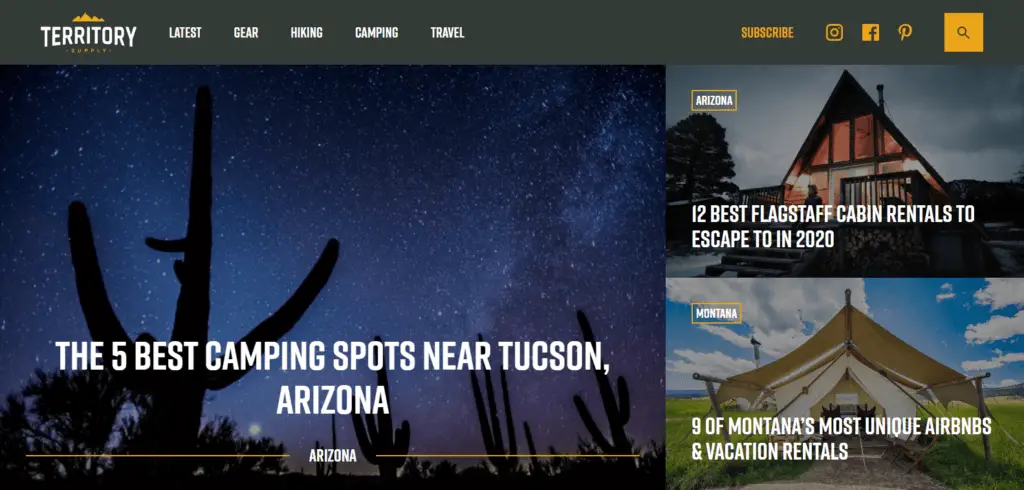
Here is how they violate Amazon’s policies
They mention generalized pricing. This was not hard to spot at all since they do it right in the title of many of their articles! In the one article that I clicked over to – they even mention price within the content. Here is how one sentence reads… “The original list price on the Talus is over $100, but a quick search on Amazon will produce the same boot for $100.”
Amazon’s policy regarding this is extremely clear. Here is how it reads…
You must not make inaccurate, overbroad, deceptive or otherwise misleading claims about any Product, an Amazon Site, or any of our policies, promotions, or prices.
I underlined the 2 of the important words in that statement; overbroad and prices. Amazon doesn’t allow ANY mention of price whatsoever. The reasoning is simple and clear. Prices on Amazon change constantly and published content on the web may not. Amazon does not want publishers to deceive their potential buyers by displaying pricing information that may not be accurate.
Here is how Amazon’s policy gets more specific as it continues like this…
Product prices and availability may vary from time to time. Because prices for and availability of Products that you have listed on your Site may change, your Site may only show prices and availability if: (a) we serve the link in which that price and availability data are displayed, or (b) you obtain Product pricing and availability data via PA API and you comply with the requirements regarding use of PA API in the License.
I actually clicked through to Amazon from several of the boots mentioned on this page on Territory Supply and found more than one that cost more than $100! Several boots vary in price based on size and color. But others were more than $100 at the lowest end of their price range! Take a look at this boot on Amazon that was listed on that page as being one of the boots that costs less than $100. It’s lowest cost on Amazon on the day that I looked was $131.88. This is what is known as a “deceptive or otherwise misleading claim” about a product on Amazon.

Here is how they could improve
Territory Supply is almost 100% legit and compliant. Most of their review posts are perfectly fine – but the ones like this that mention price could use a little bit of work.
They do link to the same products on other websites – but it appears that they are okay with this because they are not using Amazon content (like images). I don’t know where they are getting their images – but several that I checked were not the same as the product on Amazon.
This actually presents another issue. This could be considered another form of presenting misleading or inaccurate information. Their readers see one boot pictured on the website and then click over to Amazon and see a different version of the same boot. It’s highly likely that Territory Supple DID use older Amazon images and the images for the product on Amazon have since changed. This is exactly the reason that Amazon requires it’s affiliates to use images from the API – so that current images are always displayed.
In my opinion – Territory Supple should connect to the Amazon API and display their images that way. But if they do this – then they can no longer link to the same products on other websites.
I also think that a nice comparison table at the top of each product review post (like the one I analyzed) would go a long way in increasing clicks over to Amazon and conversion.
[social_warfare]
7. The Wirecutter
An extremely popular product review website focusing on any and every niche under the sun – Here are a few quotes from the Ahrefs blog article about this site…
Why they’re doing so well
Short story: they rank on the first page for 62,000+ “best” keywords in the U.S. alone:
The longer story: they’re the absolute champion of product reviews.
How to replicate their success
Focus on creating thorough, well-researched posts for “best [category]” type keywords in your industry. That means testing the products yourself where possible, and potentially even coming up with innovative ways to do so.
Here are my observations
Ah yes. The Wirecutter. No doubt – the most well-known and probably most successful Amazon affiliate website that exists anywhere on the interwebs. The Wirecutter was started in September 2011 and was acquired by The New York Times Company in October 2016 for $30 million.
It’s difficult to try to compare and contrast this product review website to typical Amazon affiliate sites just because of its mere size and the scope of different topics and products that they cover. The Wirecutter obviously employs a huge team of writers, editors and even SEO specialists. It would be nearly impossible for an ‘average Joe’ WordPress blogger to try to emulate their success.
Moving on to the site itself and the product reviews. It’s easy enough to navigate around using the header menu. I checked out several different product reviews. One thing I noticed… The Wirecutter doesn’t just promote products sold on Amazon. They promote products for sale from a bunch of different online retailers.
I did find a good example post to highlight that includes links to a few products on Amazon. Here is The Wirecutter’s post on ‘The Best Toaster Oven’. Their review process is second to none and it shows in their content. They really do purchase every product and run thorough tests. Instead of just pointing out a bunch of products with regurgitated information from the internet – they make actual recommendations based on their research and findings.

Here is how they violate Amazon’s policies
They do not clearly identify themselves as an Amazon affiliate. Period. In fact, I didn’t see anywhere on that page where they identified themselves as an Amazon affiliate at all. The closest thing I could find was the blurb at the very top of the page (right under the header menu) where it reads…
Wirecutter is reader-supported. When you buy through links on our site, we may earn an affiliate commission. Learn more
Amazon’s policy regarding this is extremely clear. Here is how it reads…
You must clearly state the following, or any substantially similar statement previously allowed under this Agreement, on your Site or any other location where Amazon may authorize your display or other use of Program Content: “As an Amazon Associate I earn from qualifying purchases.”
I even clicked on the Learn more link which I assumed would lead to an Amazon affiliate disclosure page. It sort of does… but even that page does not mention their affiliate relationship with Amazon at all. Not even once!
They cloak their links. Hover over any Amazon affiliate link in one of their posts and you will see that it looks something like this…
https://thewirecutter.com/out/link/7944/23365/4/71067?merchant=Amazon
This is a cloaked link. The URL appears to be another URL on their website – but it redirects to the Amazon product page using their Tracking ID. Amazon’s policy on this can’t be any more clear. Here is how it reads…
You will not cloak, hide, spoof, or otherwise obscure the URL of your Site containing Special Links (including by use of Redirecting Links) or the user agent of the application in which Program Content is displayed or used such that we cannot reasonably determine the site or application from which a customer clicks through such Special Link to an Amazon Site.
It’s possible that these particular ‘cloaked’ links are allowable under the clause in that statement – “that we cannot reasonably determine the site or application from which a customer clicks through such Special Link to an Amazon Site.” Because the end of the link includes merchant=Amazon – perhaps this is reasonable enough for somebody to determine that the link is leading to Amazon.
But in my opinion – it would be better to stay safe and not cloak links at all.
They display slightly inaccurate pricing information. I actually clicked on lots of different Amazon links from lots of different review posts on The Wirecutter. Almost none matched the EXACT price on Amazon. What I found was that the prices displayed on The Wirecutter seemed to use the API price from Amazon but rounded to the nearest whole number. Below is an image for a product box listing the toaster oven as selling for $268 from Amazon – and the actual price on Amazon when I checked was $267.91.
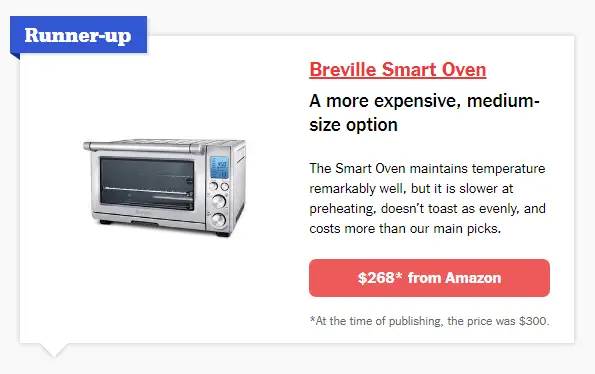
This is yet another blatant violation of Amazon’s policies. Amazon’s policy regarding this is extremely clear. Here is how it reads…
You must not make inaccurate, overbroad, deceptive or otherwise misleading claims about any Product, an Amazon Site, or any of our policies, promotions, or prices.
I underlined the words inaccurate and prices – as the prices shown in their product boxes are close – yet clearly inaccurate. I probably tested 20 different Amazon links on different pages on The Wirecutter and every single one seemed to round to the nearest whole number based on the actual price at the time.
They link to other online stores on the same pages that they use Amazon data (images) to promote products. This is a lesser-known and somewhat obscure violation – but nevertheless it IS a violation.
Amazon does not want you to (and they do not allow you to) use information from their site or their PA-API to promote or sell products on other websites. Can you blame them? Here is how the rule reads within Amazon’s policies…
You will not display on your Site, or otherwise use, any Program Content to advertise or promote any products that are offered on any site that is not an Amazon Site (e.g., products offered by other retailers).
The words, “any Program Content,” refer to anything made available by Amazon (like images). Just on this one review article alone – I found that they use Amazon images to promote products and they also link to products on Walmart. Amazon’s rules clearly state that you cannot link to other online stores if you use Amazon content to promote products.
I can’t really prove that the images they use were ‘stolen’ from Amazon – but they are the exact same images as seen on Amazon, so I think it’s pretty safe to assume that they downloaded the images from Amazon and used them on their site. Take a look at the product box below…

I investigated the Amazon listing for this product and the Walmart listing. The image on The Wirecutter is the exact same image as used on Amazon – right down to the digital display on the toaster oven matching exactly. The Walmart listing uses completely different images.
They do not include a date/time stamp near their pricing data for Amazon products. Amazon prices change constantly. It appears that The Wirecutter is using a rounded-off version of the actual price pulled from Amazon.
Amazon’s rules regarding the display of a date/time stamp are extremely clear. They even include examples of acceptable formats. Here it is, straight from the Operating Policies page…
You will include a date/time stamp adjacent to your display of pricing or availability information on your application if you obtain Product Advertising Content from Data Feeds, or if you call PA API or refresh the Product Advertising Content displayed on your application less frequently than hourly.
Examples of acceptable messaging include:
• Amazon.com Price: $ 32.77 (as of 01/07/2008 14:11 PST- Details)
• Amazon.com Price: $ 32.77 (as of 14:11 EST- More info)
I did not find any date/time stamps next to any of the Amazon prices displayed on The Wirecutter. This could be very problematic – as prices for products on Amazon can change very frequently.
For example: a potential customer might research a product one day and pull up a review post on The Wirecutter. Maybe they leave that page open then come back the next day to purchase. The price may have changed and there is no date/time stamp on The Wirecutter to tell them when that pricing was accurate.
Here is how they could improve
Being known as probably the most successful affiliate site on the internet – it seems absurd for me to offer advice on improvement. Obviously, they could benefit by fixing the minor compliance issues I mentioned above. Other than that – I don’t know what else to say. They already do an incredible job with their product reviews and I don’t see how they could possible be improved.
Avoid their compliance issues and this makes a great Amazon affiliate website example.
[social_warfare]
Final thoughts on using successful Amazon Affiliate Websites for inspiration and ideas …
After doing a deep-dive and critique on all seven of these highly succesful affiliate sites – I can honestly say that I’m refreshed and encouraged. It’s rare that I spend the kind of time that I did to dig into so many aspects of sites like these.
I’m refreshed because I’m inspired by these sites and kind of have new energy to up my game as an Amazon affiliate.
I’m encouraged because I know that all of these sites started small and grew into what they currently are – over time. Anybody can do this! It’s motivating to realize that you and I and anybody else can have just as much success as some of these big players -as Amazon affiliates.
Do Bigger Sites Play by Different Rules?
I found Amazon compliance violations for almost all of the sites mentioned in this article. Have you ever wondered, like I have, whether some of these big players get to play by a different set of rules than the rest of us? Do they get special exemptions from Amazon? Does Amazon just ignore their violations because they send so much traffic to Amazon and drive a bunch of sales?
Stay Compliant – Know the Rules and Play it Safe
Here at AmaLinks Pro® – we take Amazon compliance VERY seriously. We’ve spent many hours upon hours reading through the Amazon policy documents to make sure that our Amazon affiliate WordPress plugin is 100% compliant with all of the rules and regulations. If you use AmaLinks Pro® to insert your Amazon affiliate links – you can be confident that your links are compliant.
Learn More About AmaLinks Pro®
Furthermore – we’ve put together a mini-training series that goes over many of the common and less-common violations that a lot of people make. Our Level Up Series covers this stuff as well as several strategies to help you boost your conversions and Amazon affiliate income!
Sign up for the Level Up Series by inserting your email address in the box at the bottom of this page.
We sincerely hope you learned a thing or two in this article. We’ll see you on the inside after you sign up for our Level Up Series!
[social_warfare]




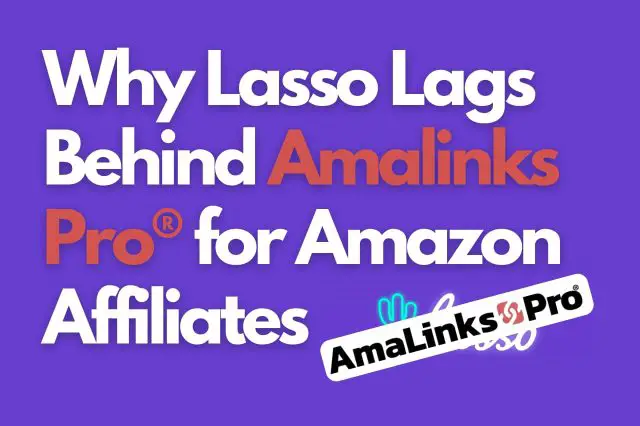
Great article! Very helpful.
Would you mind showing us some good examples that are actually done according to Amazong guidelines please?
Hey Mike – good idea for a future post! The only issue being that I wouldn’t want to ‘call out’ sites that don’t want to be highlighted like that. I’d have to get permission from the site owners. In the case of this post – I just used the exact same sites that were already mentioned in the Ahrefs blog post.
But you think these sites want to be ‘called out’ for possibly breaking the Amazon TOS?
What you’ve done here is effectively highlighted the business risk of all these sites, and posted it publicly, thereby making the risk more real.
Did you reach out to each one before outing them? Judging by your comment, it sounds like you didn’t
Everyone wants to create content that attracts attention, but doing so at the expense of others? Not cool.
You might get a few extra clicks, but the SEO-affiliate space is a small world…I don’t think this is going to do good things for your reputation.
Hey John – have you ever tried contacting the webmaster for a huge website, like the ones I mentioned in this post? Do you think I would even get a response even if I did try to contact them?
For sites this large that make SO much money from Amazon’s affiliate program… you would think they would take an hour or two to scour Amazon’s policy documents themselves. Or hire a lawyer to do it for them. But they’ve been getting away with breaking the rules for so long – so why should they care?
Did I write this post to attract attention? Maybe a little. But more so, I wrote it to actually help Amazon affiliates. Could I have written the post without using real examples? Sure! Would it be nearly as helpful as this post that points out real examples from real successful sites? I don’t think so. This is why I chose to target these huge and successful sites. They can handle it. Can you imagine the pushback I would have received if I did this for a whole bunch of smaller sites from solo entrepreneurs…? Yeah, that would have been not cool.
Anybody can write a post highlighting the success of others, and lots of people do. Those posts are motivating and helpful. But somebody needs to go the other way and publish content like what I’ve published here. In the end – I honestly think this is going to help a lot of people and I seriously doubt any of these large sites will get so much as a warning email from Amazon.
Hi John, and thanks for your opinion. Did you forget that Ahrefs called out these sites as examples of successful affiliate websites to the public? That in itself was irresponsible to do without pointing out these HUGE Amazon compliance issues. That article will result in a lot of new affiliates and beginners trying to mimic these sites.
We take Amazon compliance VERY SERIOUSLY here at AmaLinks Pro®, it is OUR DUTY to call out these sites due to Ahrefs already making these examples widely known to the public – to save others from copying their disregard for the Amazon Associate compliance terms.
We did not do this for attention, we did this as our duty to help educate our customers and potential customers about Amazon Affiliate compliance to keep them from having their accounts getting banned.
This is exactly the type of duty and care for our customers we have and always will – and what we built our trusted reputation on.
– AC
Great article which highlights the fact that Amazon does seem to allow bigger sites more freedom. It is never easy with Amazon as if you build a post and need a featured image and this needs to be the same as the product. How do you get around this?
Yeah Kevin – unfortunately there is no easy way to use an Amazon image as a featured image in WordPress (and stay compliant). Featured images in WP MUST be uploaded – and Amazon doesn’t allow you to download/upload their images. There are ways to get creative. Using images of people is never a bad idea. Search for images of people using similar products. If possible, purchase the product yourself and take pictures and upload your own images! Try to think outside the box…
Awesome post – I’d noticed the cloaking on Wirecutter before, but some of those other policy violations had escaped me. It does appear that big sites get to play by different rules, but for those of us trying to be compliant, this is a great list of things to avoid, thanks!
I am amazed that some affiliate plugins (*cough* AAWP *cough*) ignore Amazon’s terms (scraping review data) and nothing is done about it (yet…).
Yeah Tom – it is really unfortunate for AAWP customers that they could be putting their Amazon Associates accounts at risk just by using some of the features provided. I’m guessing you read this article on our blog with absolute proof that AAWP is blatantly breaking the rules – https://amalinkspro.com/can-i-show-amazon-star-ratings-on-my-website-or-blog/
This post proves that you are trying to sell amalinkspro by creating fear in the minds of affiliates while none of these sites are banned by Amazon.
Or are you accusing Amazon that they have different rules for bigger players?
Yes Neo – all of the above. Amazon affiliates should be afraid if they are breaking rules just like the ones I point out in this post. They should be afraid that their accounts could be banned any day and they could lose all of their current and future earnings.
Am I accusing Amazon of not enforcing their rules for bigger players? Absolutely!! Why have the rules in place at all if they aren’t going to be enforced? With the amounts of traffic that these sites send to Amazon – you would think that they surely had to undergo a manual review.
Neo, have you seen the amount of stories of people getting their accounts banned for these exact same violations?
The article is very informative. Could you please cover more websites for beginner level. All the above websites are advanced level. BTW Thank you
Wow, great analysis on each of the websites.
I must admit i have some (many) of the violations mentioned in my own page, time to get them corrected before they pile up.
Thanks for the information.
No problem Luis! We’re really glad that this post was helpful for you.
Hi thanks for details analysis but this is very strange and awful that the big sites seems to be given virtual pass by amazon, only because they are sending amazon lots of referral, while same violation can be treated with ban on small affiliate.
Can we have a post about affiliates’s experience who got banned by Amazon based on violation of policies and guideline , this will be helpful to understand the other part also.
Thanks &Regards
You’re right Anil. It is strange and awful. I only wish I could write the post you request… but, that would present a much more challenging effort than it was even to write this post! I would have to find and interview people who have had the experience of getting banned by Amazon. Not sure I’m up for that challenge at this time.
Thanks for the explanation, you’re doing a great job.
Does it violate the rules of amazon to display a page with for example: 5 amazon products, underneath 5 Ebay products and underneath 5 products of other brands?
Paragraph 1 = 5 amazon products
Paragraph 2 = 5 Ebay products
Paragraph 3 = 5 other vendors (mixed)
Thank you very much
What you’re describing sounds okay. It doesn’t appear that this would violate rules – as long as you aren’t using any of Amazon’s data to promote the products on the other platforms. For example – you couldn’t use an image from Amazon in the Ebay section, but promote the product for sale on Ebay.
Thanks for your information, I don’t know these sites before reading this but now I got full detailed information about these amazon affiliates sites.
Thanks for information
This was a fantastic post, thank you! The one topic I’m not quite clear on is links to other affiliate programs in a post that contains Amazon affiliate links. I have a few posts where I review a particular product subject. Most of the links go to Amazon, but one or two go elsewhere. For those links it’s always a different product (though it may be available from Amazon) and I use an image provided by the different affiliate site. In other words, the product is separated by name and image from the Amazon products being promoted. I don’t use anything from Amazon to promote those links other than the post topic itself. Is that OK?
Hey Shea – what you are describing sounds perfectly acceptable. As long as you aren’t using Amazon content (like images) to promote specific products on other sites. Sounds like you are doing it correctly.
Thanks for your information, I didn’t know these sites before reading this but now I have full details about these amazon affiliate sites.
Thanks for the information
This is freaking inspiring, man! Thanks for sharing !
This is a fabulous post, thanks for sharing it with us. I also run an affiliate website (procoffeeguide.com) and have some issues with amazon affiliates. But, Now I got full detailed information about these issues.
Just got started as an affiliate. This article is extremely helpful, well planned out, and has great information. Thank you for sharing!
Hey, nice article about successfull “Amazon affiliate websites”. I will definitely follow these for my company to give the best possible services to my customers. Keep on adding this type of valuable content again and again. Hope to read more from you. Thank you!